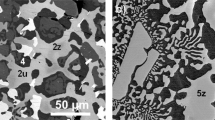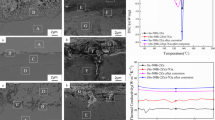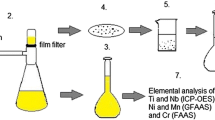Abstract
The anomalous codeposition of the iron group metals was investigated using the rotating cylinder Hull (RCH) cell. Single metals and binary alloys of iron, nickel and cobalt were deposited in the RCH cell and the partial current densities were determined as a function of length by position sensitive X-ray fluorescence analysis. The measured overall polarization behaviour was used as a boundary condition for the numerical calculation of the potential distribution along the cylinder using the Laplace equation. By combining the results the partial current density potential curves were established. Experiments performed at different rotation rates confirmed the inhibiting effect of the less noble metal on the deposition of the more noble metal. The inhibiting effect of iron on nickel disappeared when iron reached the limiting current. Strong evidence was found that in binary alloy deposition of iron, cobalt and nickel the reaction rate of the less noble metal is promoted by the presence of the more noble component.
Similar content being viewed by others
References
H. Dahms and I. M. Croll, J. Electrochem. Soc. 112 (1965) 771.
P. C. Andricacos and L. T. Romankiw, ‘Magnetically Soft Materials in Data Storage: Their Properties and Electrochemistry’, in Advances in Electrochemical Science and Engineering, Vol. 3 (1994), p. 226.
K. Ohashi, M. Ito and M. Watanabe, ‘Application of Electroplating to Thin Film Heads: An Overview’, Electrochem. Soc. Proc. 88-23 (1988) 525–42.
P. L. Cavallotti, B. Bozzini, L. Nobili and G. Zangari, J. Electrochim. Acta 39 (1994) 1123.
C. A. Ross, Ann. Rev. Mater. Sci. 24 (1994) 159.
R. Chesnutt, J. Appl.Physics. 73 (1993) 6223.
R. L. White, Plat. Surf. Finish. 75 (1988) 70.
S. S. Djokic, M. D. Maksimovic and D. C. Stefanovic, J. Appl. Electrochem. 19 (1989) 802.
P. Duke, T. Montelbano and L. Misel, Plat. Surf. Finish. 69 (1982) 61.
B. Löchel, and A. Maciossek, J. Electrochem. Soc. 143 (1996) 3343.
A. Thommes, W. Stark, K. Leyendecker, W. Bacher, H. Liebscher, and Ch. Jakob, ‘LIGA Microstructures from a NiFe-Alloy: Preparation by Electroforming and their Magnetic Properties’, Electrochem. Soc. Proc. 94-6 (1994) 89–102.
A. Brenner, ‘Electrodeposition of Alloys’, Vols. 1-2 (Academic Press, New York, 1963).
D. Landolt, Electrochim. Acta 39 (1994) 1075.
M. Matlosz, J. Electrochem. Soc. 140 (1993) 2272.
D. Gangasingh and J. B. Talbot, J. Electrochem. Soc. 138 (1991) 3605.
W. Grande and J. B. Talbot, J. Electrochem. Soc. 140 (1993) 675.
P. C. Andricacos, C. Arana, J. Tabib, J. Dukovic and L. T. Romankiw, J. Electrochem. Soc. 136 (1989) 1336.
K. H. Wong, P. C. Andricacos and L. T. Romankiw, ‘Effect of Fe(II) Concentration on the Electrodeposition of Nickel-Iron Alloys’, Electrochem. Soc. Proc. 90-8 (1990) 387–396.
S. Hessami and C. W. Tobias, J. Electrochem. Soc. 136 (1989) 3611.
B. C. Baker and A. C. West, ibid. 144 (1997) 169.
C. Madore and D. Landolt, Plat. Surf. Finish 80 (1993) 73.
C. Madore, A. C. West, M. Matlosz and D. Landolt, Electrochim. Acta 37 (1991) 69.
C. Madore, PhD thesis no. 1189, Ecole Polytechnique Fédéral Lausanne, Switzerland (1993).
C. Madore, M. Matlosz, D. Landolt, J. Appl. Electrochem. 22 (1992) 1155.
C. Madore, D. Landolt, C. Hassenpflug, J. A. Hermann, Plat. Surf. Finish. 82 (1995) 36.
A. C. West, M. Matlosz and D. Landolt, J. Appl. Electrochem. 22 (1992) 301.
M. Matlosz, C. Creton, C. Clerc and D. Landolt, J. Electrochem. Soc. 134 (1987) 3015.
M. Matlosz, ‘Boundary Element Calculations in Design’, Electrochem. Soc. Proc. 95-11 (1995) 221–36.
E. J. Podlaha and D. Landolt, J. Electrochem. Soc. 143 (1996) 885.
P. C. Andricacos, ‘On the Anomalous Codeposition of Ferrous Metal Alloys’, Electrochem. Soc. Proc. 94-31 (1994) 157–76.
A. A. El Miligy, F. Hilbert and W. J. Lorenz, J. Electrochem. Soc. 120 (1973) 247.
N. Zech, E. J. Podlaha and D. Landolt, to be published.
K. Y. Sasaki and J. B. Talbot, J. Electrochem. Soc. 142 (1995) 775.
D. Landolt, N. Zech, E. J. Podlaha, Z. Phys. Chem., submitted.
K. Y. Sasaki and J. B. Talbot, J. Electrochem. Soc. 145 (1998) 981.
Author information
Authors and Affiliations
Rights and permissions
About this article
Cite this article
Zech, N., Podlaha, E.J. & Landolt, D. Rotating cylinder Hull cell study of anomalous codeposition of binary iron-group alloys. Journal of Applied Electrochemistry 28, 1251–1260 (1998). https://doi.org/10.1023/A:1003416328942
Issue Date:
DOI: https://doi.org/10.1023/A:1003416328942




